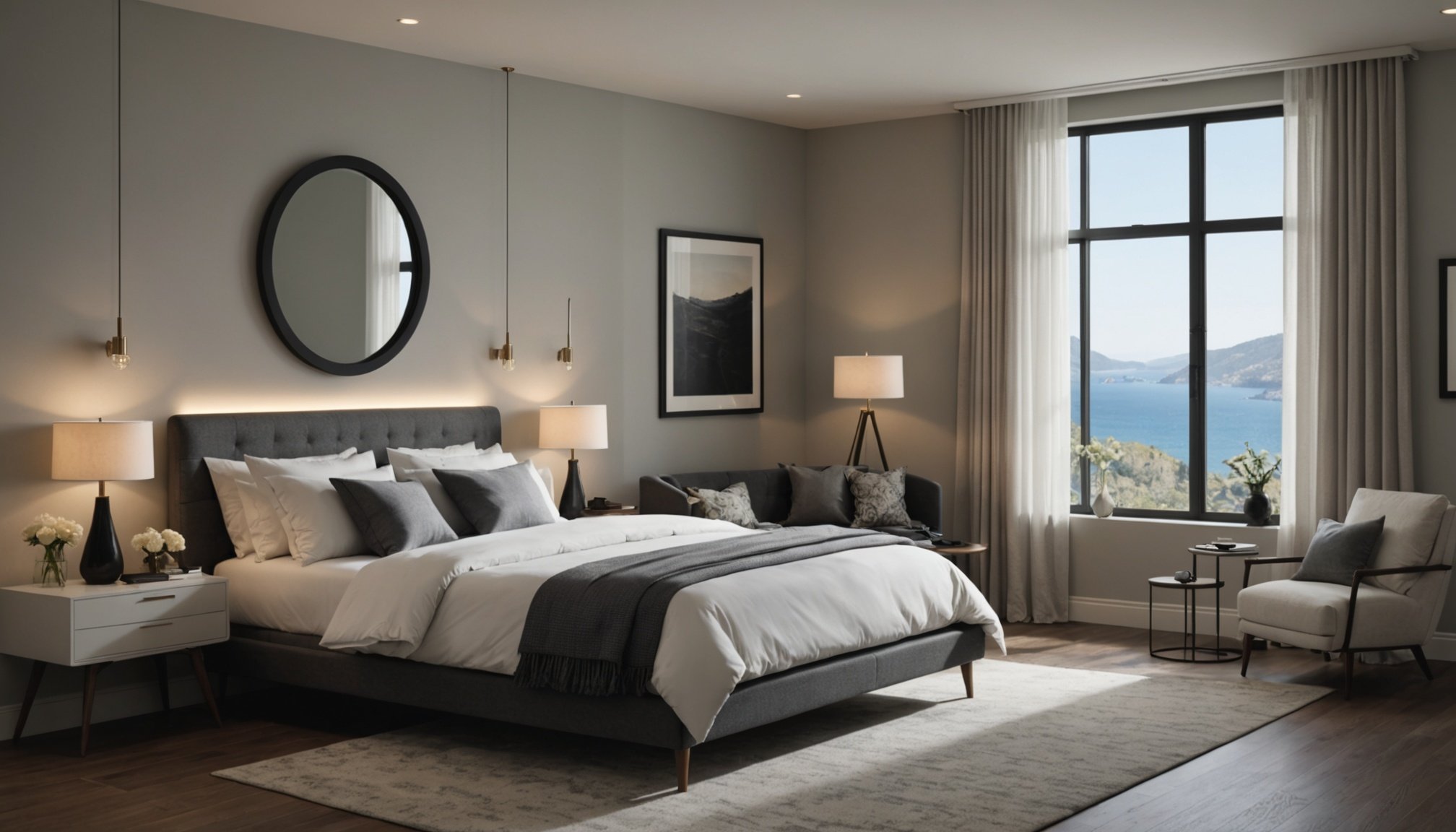Transform Your Sleep Sanctuary: Enhance Rest and Glow with an Optimal Sleep Environment
Creating a sleep sanctuary is more than just a luxury; it’s a necessity for achieving quality sleep and overall well-being. Your sleep environment plays a crucial role in determining the quality of your rest, and making a few simple adjustments can significantly enhance your night sleep. Here’s a comprehensive guide to help you transform your bedroom into a sleep haven.
Optimize Your Sleep Environment
The Importance of a Cool, Dark, and Quiet Space
Your bedroom should be a haven of tranquility, free from distractions that can disrupt your sleep. Here are some key elements to focus on:
Also to read : Revamp Your Modern Wardrobe: Creative Ways to Style Vintage Belts
- Temperature: The ideal room temperature for sleep is between 60°F and 65°F (15.6°C to 18.3°C). This range helps your body’s internal temperature decrease, which is essential for falling asleep and maintaining restful sleep throughout the night[5].
- Light: Ensure your bedroom is dark by using blackout curtains or an eye mask. Light can interfere with your body’s production of melatonin, the hormone responsible for regulating sleep[1][3].
- Noise: A quiet environment is crucial. Use earplugs or a white noise machine to block out any unwanted noise that might disturb your sleep[1][3].
Creating a Relaxing Atmosphere
- Soft Lighting: Replace harsh lights with soft, calming lighting. This can include dim lamps or string lights that create a soothing ambiance.
- Calming Scents: Incorporate calming scents like lavender or chamomile into your bedroom. These scents can promote relaxation and help you fall asleep faster[1].
Choose the Right Mattress and Pillow
The Foundation of Comfort
Your mattress and pillow are the cornerstone of a comfortable sleep environment. Here’s what you need to consider:
-
Mattress: Invest in a high-quality mattress that provides adequate support for your body. A memory foam mattress, for example, can offer the right balance of comfort and support, keeping your spine properly aligned[1][3].
Also to discover : Awaken your glow: the essential blueprint for creating an effective morning skincare ritual
-
Key Features:
- Support: Ensure the mattress supports your body weight evenly.
- Comfort: Choose a mattress that suits your sleeping position (side, back, or stomach).
- Material: Consider hypoallergenic materials if you have allergies.
- Warranty: Look for a mattress with a good warranty and return policy.
-
Pillow: Your pillow should provide proper support for your head and neck, promoting a neutral alignment.
-
Key Features:
- Support: Ensure the pillow keeps your neck in alignment with your spine.
- Comfort: Choose a pillow that suits your sleeping position and personal preference (firm or soft).
- Material: Consider breathable materials like cotton or bamboo.
Practical Tips for Choosing the Right Mattress and Pillow
- Test Before You Buy: If possible, test the mattress and pillow in person before making a purchase.
- Read Reviews: Check reviews from other users to get a sense of the product’s performance and durability.
- Consider Your Sleeping Position: Side sleepers may prefer softer pillows and mattresses, while back sleepers may prefer medium-firm options, and stomach sleepers may prefer firmer options.
Create a Bedtime Routine
Signaling Your Body for Sleep
A consistent bedtime routine helps signal to your body that it’s time to sleep. Here are some activities you can include:
- Reading a Book: Reading can be a great way to wind down and relax before bed. Choose a book that is not too stimulating or exciting.
- Taking a Warm Bath: A warm bath can help your muscles relax and prepare your body for sleep.
- Practicing Relaxation Techniques: Activities like deep breathing, meditation, or yoga can help reduce stress and promote relaxation[1][3].
Avoid Stimulating Activities Before Bed
- Electronic Devices: Avoid using electronic devices like smartphones, tablets, or computers at least an hour before bedtime. The blue light emitted from these devices can interfere with your sleep[1][3].
- Watching TV: While watching TV might seem relaxing, it can be too stimulating and make it harder to fall asleep.
- Engaging in Intense Conversations: Avoid engaging in intense or stressful conversations before bed as they can keep your mind active.
Maintain a Consistent Sleep Schedule
Regulating Your Body’s Internal Clock
Consistency is key when it comes to establishing healthy sleep patterns. Here’s why:
- Same Time Every Day: Try to go to bed and wake up at the same time every day, even on weekends. This helps regulate your body’s internal clock and promotes better sleep quality[1][3].
- Avoid Long Daytime Naps: While short naps can be beneficial, long or irregular daytime naps can interfere with your ability to fall asleep at night. Keep naps short, around 20 minutes, and avoid napping too close to your regular bedtime[1][4].
Practical Tips for Maintaining a Consistent Schedule
- Set a Fixed Wake-Up Time: Set your alarm for the same time every day, including weekends.
- Gradual Adjustments: If you need to adjust your sleep schedule, do it gradually to avoid disrupting your body’s internal clock.
- Avoid Snoozing: Snoozing can disrupt your sleep patterns and make it harder to wake up feeling refreshed.
Incorporate Exercise into Your Routine
The Impact of Physical Activity on Sleep
Regular physical activity can significantly improve sleep quality and help alleviate pain and discomfort in the body. Here’s what you need to know:
- Moderate-Intensity Exercise: Aim for at least 30 minutes of moderate-intensity exercise most days of the week. This can include activities like walking, cycling, or swimming[1][3].
- Avoid Exercise Before Bedtime: While exercise is beneficial, avoid intense exercise close to bedtime as it can have a stimulating effect on your body and make it harder to fall asleep.
Practical Tips for Incorporating Exercise
- Schedule Your Workouts: Plan your workouts for the morning or early afternoon to avoid interfering with your sleep.
- Choose Low-Intensity Activities Before Bed: If you need to do something physical before bed, opt for low-intensity activities like stretching or light yoga.
Manage Stress and Anxiety
The Impact of Stress on Sleep
High levels of stress and anxiety can significantly impact your sleep quality. Here are some strategies to help manage stress:
- Mindfulness and Relaxation Techniques: Practice mindfulness, deep breathing, or meditation to help reduce stress before bedtime[1][3].
- Journaling: Writing down your thoughts and feelings can help clear your mind and reduce stress.
- Seek Professional Help: If chronic pain or stress is a source of anxiety for you, consider seeking professional help. Pain management techniques and therapy can provide effective strategies for managing and reducing pain to promote better sleep[1].
Practical Tips for Managing Stress
- Create a Stress-Free Zone: Make your bedroom a stress-free zone by removing any work-related items or electronic devices.
- Engage in Relaxing Activities: Engage in relaxing activities like listening to calming music or practicing gentle stretches before bed.
Watch Your Diet and Caffeine Intake
The Impact of Diet on Sleep
What you eat and drink can have a direct impact on your sleep. Here are some dietary tips to keep in mind:
- Avoid Heavy Meals: Avoid heavy meals, spicy foods, and excessive caffeine, especially in the evening hours. Opt for lighter meals and choose sleep-friendly snacks if you need a pre-bedtime snack[1][3].
- Limit Fluid Intake Before Bed: Reduce your fluid intake close to bedtime to avoid disruptive trips to the bathroom during the night.
Practical Tips for a Sleep-Friendly Diet
- Eat a Balanced Diet: Focus on eating a balanced diet rich in fruits, vegetables, and whole grains.
- Avoid Stimulants: Avoid consuming stimulants like caffeine, nicotine, and alcohol close to bedtime.
Additional Tips for Creating an Optimal Sleep Environment
Limit Exposure to Screens Before Bedtime
- Blue Light: The blue light emitted from screens can interfere with your sleep. Avoid using electronic devices at least an hour before bedtime[1][3].
Avoid Clock-Watching
- Stress Reduction: If you have trouble falling asleep, constantly checking the time can add to your stress. Turn your clock away from view to prevent this habit[3].
Seek Natural Light Exposure During the Day
- Regulate Your Body’s Sleep-Wake Cycle: Exposure to natural light during the day can help regulate your body’s sleep-wake cycle. Spend time outdoors or keep your curtains open to get some daylight[3].
Table: Comparing Key Elements for an Optimal Sleep Environment
| Element | Description | Benefits |
|---|---|---|
| Cool, Dark, and Quiet | Maintain a room temperature between 60°F and 65°F, use blackout curtains, and minimize noise. | Promotes better sleep quality, reduces sleep disruptions. |
| High-Quality Mattress | Invest in a mattress that provides adequate support and comfort. | Improves sleep posture, reduces discomfort and pain. |
| Consistent Sleep Schedule | Go to bed and wake up at the same time every day. | Regulates body’s internal clock, promotes better sleep quality. |
| Relaxation Techniques | Engage in activities like deep breathing, meditation, or yoga before bed. | Reduces stress and anxiety, promotes relaxation. |
| Moderate-Intensity Exercise | Engage in at least 30 minutes of moderate-intensity exercise most days. | Improves sleep quality, alleviates pain and discomfort. |
| Stress Management | Practice mindfulness, journaling, or seek professional help for stress management. | Reduces stress and anxiety, promotes better sleep. |
| Sleep-Friendly Diet | Avoid heavy meals, spicy foods, and excessive caffeine before bedtime. | Promotes better sleep quality, reduces sleep disruptions. |
Quotes and Insights from Experts
- “Optimal sleep hygiene is not identical for everyone, but there are some things that typically can help most people get a good night’s sleep,” says Dr. Axe. “Sticking to a consistent sleep schedule, creating a bedtime routine, and making your sleep environment comfortable are key”[3].
- “The ideal room temperature for sleep is anywhere from 60°F to 65°F. This range helps your body’s internal temperature decrease, which is essential for falling asleep and maintaining restful sleep throughout the night,” notes Healthline[5].
Transforming your sleep sanctuary into an optimal sleep environment is a holistic process that involves several key elements. From choosing the right mattress and pillow to maintaining a consistent sleep schedule and managing stress, every detail counts. By following these tips and creating a sleep-friendly environment, you can significantly enhance your sleep quality, leading to better rest, improved memory, and overall well-being.
Remember, your sleep sanctuary is your haven, and investing time and effort into creating the perfect environment will pay off in the long run. So, take the time to prioritize your sleep, and you’ll reap the benefits of improved energy, mood, and a healthier life.
Aroma and Sleep Enhancement
Fragrances can significantly enhance our sleep experience. By utilising specific sleep scents, we can create a calm and soothing environment that promotes better rest.
Utilizing Essential Oils
Essential oils like lavender, chamomile, and cedarwood are popular choices for their calming aromas. These oils are renowned for their ability to reduce anxiety, ease the mind, and potentially lower heart rate. Safe methods to apply these oils include direct inhalation, diffusion, or dilution in carriers for application on pulse points. When used carefully, they can be integrated into bedtime routines for improved sleep quality.
Scent Diffusers and Candles
Consider introducing scent diffusers or candles into a sleep routine to enjoy continuous aroma release. Diffusers featuring ultrasonic technology can be ideal, as they disperse essential oils gently. Alternatively, selecting sleep-friendly candles infused with natural oils allows for a more aesthetic approach. It’s crucial to select scents that are personally soothing, as preferences play a crucial role in the effectiveness of relaxation.
Creating a Personal Sleep Aroma
To craft a unique aroma, combine essential oils in small amounts to find what resonates with personal preferences. Begin with known relaxing scents, adding hints of other fragrances for a bespoke blend. Experimenting with proportions will lead to a finely tuned signature scent that ensures a soothing night’s sleep. Remember, discovering effective sleep-enhancing aromas involves patience and awareness of individual responses.
Managing Bedroom Temperature
Achieving the optimal sleep conditions is closely tied to sleep temperature and thermoregulation. The ideal temperature range for quality sleep typically lies between 15.6°C and 19.4°C. Maintaining this range is crucial as it aligns with your body’s natural drop in core temperature during the night, enhancing sleep efficiency.
Thermoregulation plays a significant role in sleep onset and continuity. When your environment is too hot or too cold, it can disrupt these natural processes, leading to restless nights. To ensure a consistent sleep temperature, consider using tools like smart thermostats or bedroom fans. These devices allow precise control over your bedroom’s environment, ensuring it remains within the optimal range throughout the night.
Temperature fluctuations can severely impact sleep quality. Hot temperatures can lead to increased wakefulness and sweating, interrupting the sleep cycle. Conversely, overly cold environments can cause muscle contractions, stirring one awake.
To mitigate these effects, assessing other factors such as bedding and insulation is beneficial. Insulated windows can help maintain indoor temperatures, while breathable bedding materials facilitate effective thermoregulation.
Maintaining an ideal sleep temperature not only supports better sleep but also enhances overall well-being. Integrating temperature-regulating tools and optimizing bedroom conditions can lead to improved sleep quality and health.
Reducing Noise for Better Sleep
Finding tranquility during sleep is often disrupted by noise disturbances. Understanding and mitigating these noise issues can significantly improve sleep quality.
Understanding Sleep Disruptions
Noise in our surroundings can become a sneaky thief of sleep. Common sources of these disruptions include traffic, barking dogs, or an inconsiderate neighbour. Such disturbances can fragment sleep cycles, leading to diminished rest and increased fatigue upon waking.
Soundproofing Strategies
Effective soundproofing can be a game-changer.
- Consider sealing windows and doors more effectively, using heavy curtains or door sweeps. Acoustic panels and foam can absorb nuisance sounds and are easy to install.
- For those seeking minimalist solutions, rugs and upholstered furniture can also play a role in noise reduction.
Evaluating soundproofing products involves checking their Noise Reduction Coefficient (NRC) or Sound Transmission Class (STC) ratings, representing how well they can limit noise.
White Noise and Sleep Aids
Utilising white noise machines or apps transforms chaotic noise into consistent, soothing sounds. These tools help mask disruptive sounds and create a more stable sleep environment.
Alternatives include natural sounds like rain or gentle waves, delivered through apps or pre-recorded devices. This noise can offer a calmer state for sleep, making it an attractive option for those uninterested in soundproofing methods.
Recommendations for Sleep-Enhancing Products
Finding the right sleep products can significantly influence the quality of your rest. Among these, mattresses and pillows are essential for achieving a balanced night’s sleep. A supportive mattress is crucial, as it maintains spinal alignment and relieves pressure points. For instance, memory foam mattresses adapt to body contours, while inner-spring models offer more bounce.
Comfort items like pillows also play a vital role; they should support the neck and maintain spinal alignment. Consider options like latex pillows for durability and pressure relief, or down pillows for those who prefer a softer feel.
When discussing bedding materials, the choice of fabric can significantly enhance sleep quality. Cotton is popular for its breathability and softness, while bamboo offers moisture-wicking properties, keeping you comfortable year-round.
For individuals needing extra help with sleep onset, sleep aids might offer a solution. Non-medical options like white noise machines or aromatherapy diffusers could enhance relaxation before bed. Also, weighted blankets have shown potential in reducing anxiety and promoting deeper sleep by applying gentle pressure to the body.
By investing in these thoughtfully chosen sleep aids and comfort items, you can promote an environment conducive to restful sleep and overall well-being.
Scientific Insights on Sleep Environment
Understanding the intricacies of sleep environments through sleep research has unraveled surprising insights that influence restfulness. Scientific studies highlight the connection between sleep quality and one’s surroundings. It becomes essential not only to comprehend but also to integrate these findings into everyday life, maximising sleep benefits.
Key Research Findings
A myriad of scientific studies underscores how intricately sleep environment influences sleep effects. Research consistently reveals that even minimal changes in bedroom setup can significantly sway sleep quality. For instance, adjusting room temperature can manifest notable improvements in restfulness. Studies have shown that cooler environments generally promote deeper sleep phases and more restorative rest. Moreover, carefully curated light exposure before bedtime can affect circadian rhythms, directly impacting sleep patterns.
Recommendations Based on Research
Adopting evidence-based strategies according to research findings offers practical benefits. Ensuring an ideal sleep environment aids in achieving optimal sleep conditions. For instance, maintaining a cooler room temperature and limiting exposure to electronic screens are actionable steps. Also, incorporating blackout curtains to manage light exposure further underscores the significance of a science-backed approach. Such evidence-based adjustments not only elevate sleep quality but can also enhance overall well-being. Hence, the science is clear: a strategic bedroom setup, grounded in empirical research, has the power to transform sleep experiences.











